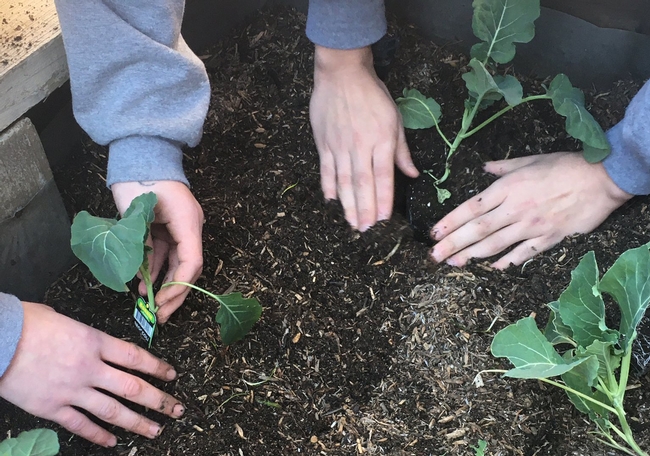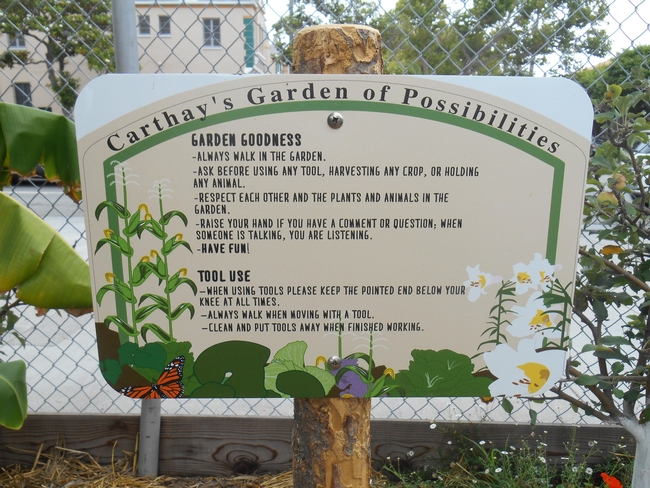Posts Tagged: Farm to school
Farm-to-school projects planned for Los Angeles and Tuolumne counties
The University of California Cooperative Extension and its community partners have received nearly $500,000 from the California Department of Food and Agriculture to expand farm to school projects. The CDFA Office of Farm to Fork's 2021 California Farm to School Incubator Grant Program has awarded $8.496 million in grants to 60 farm-to-school projects throughout the state, including the following two UC Cooperative Extension projects.
Tuolumne Agricultural Connections Project
UC Cooperative Extension in the Central Sierra received $248,457 to work on the “Tuolumne Agricultural Connections Project” with Jamestown Elementary School District, Office of Tuolumne County Superintendent of Schools, Mother Lode Regional Juvenile Detention Center, Tuolumne County Sheriff's Office and local farmers.
UC Cooperative Extension Central Sierra will work with the sheriff's office to expand an existing farm education center on land owned by the county detention center, to provide educational opportunities for public school students and juvenile detention center students.
“We're really excited to offer more learning opportunities for young people in Tuolumne County,” said JoLynn Miller, director of UC Cooperative Extension in the Central Sierra. “At the farm, we will be able to teach students about growing food with hands-on activities and field trips and provide incarcerated residents with job training.”
UCCE and the Sheriff's Office plan to start a sustainable egg-laying operation to supply public schools and other public institutions with locally produced eggs. At the juvenile detention center, UCCE will provide monthly gardening and cooking lessons to juveniles. UCCE also will support school gardens through the School Garden Network and expand Harvest of the Month education and tastings to more public schools and to the juvenile detention center. School food service directors will get help increasing procurement of California-grown foods for their menus to reinforce the Harvest of the Month education. Through Kids' Day at the Market events, they plan to introduce public school students to farmers markets as places to buy healthy foods.
Local sourcing of food across Los Angeles
In Los Angeles County, the Urban and Environmental Policy Institute at Occidental College received a $250,000 grant. Occidental College is partnering with Los Angeles Unified School District, Los Angeles County Office of Education, Adventist Health Glendale Foundation, Big Green, Enrich LA, Garden School Foundation, Los Angeles Food Policy Council, National Health Foundation, Sage Garden Project, Seeds to Plate, Sustainable Economic Enterprises of Los Angeles and UC Cooperative Extension in Los Angeles County.
The “Farm to Classroom: Sourcing Local for Farm to School Education Across Los Angeles” project will help farm-to-school educators purchase fresh produce from local farmers markets for in-class taste tests, garden lessons and recipe demonstrations. They will also offer teachers farm-to-classroom educational materials on food systems, farmers and agriculture, featured produce items and nutrition.
"We are thrilled and excited to be a partner on the project,” said Keith Nathaniel, UCCE director and 4-H youth development advisor in Los Angeles County. “Cooperative Extension in Los Angeles County is poised to provide quality educational materials that support the farm to school learning continuum for young people. Cooperative Extension will continue to build on its expertise to develop relevant impactful materials designed to engage learners to meet their educational outcomes."
A “Los Angeles Harvest of the Month” calendar will be designed for Los Angeles Unified Food Services and be available to others in Los Angeles County to use. The calendar will feature local produce items that are highlighted in the educational materials and available to buy through a purchasing app. Coordination between school food services and teachers will help Los Angeles Unified align their lessons and garden planting schedules with foods offered in the cafeteria. The project team plans to launch a pilot of the program at select Title 1 schools, then analyze evaluation data from the pilot program and modify the program model as needed before sharing it with farm to school educators across LA County and offering an accompanying training.
The California Farm to School Incubator Grant Program focuses on supporting local and regional farm to school projects that promote nutrition education, sustainable food production and procurement, and high-quality student engagement through experiential learning.
October is National Farm-to-School Month
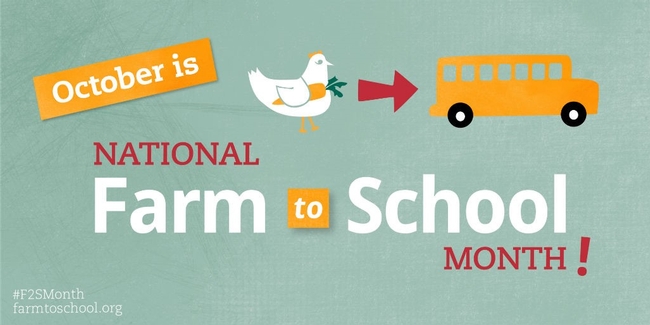
There are plenty of opportunities for teachers and schools to celebrate and get involved in National Farm to School Month with the University of California Division of Agriculture and Natural Resources (UC ANR). Here are a few ideas to get you started.
4-H youth development
Launch a 4-H Club at your school. The 4-H Youth Development Program emphasizes enrichment education through inquiry-based learning. Core content areas include Healthy Living as well as Science, Technology, Engineering and Math (STEM). Clubs have access to a wealth of curricula materials exploring food, agriculture and natural resources. 4-H also offers the Ag in the Classroom school enrichment program.
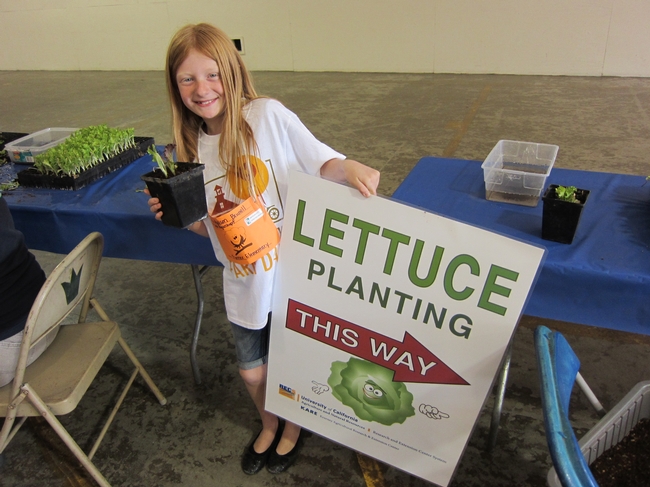
Invite UC ANR academics and program staff to your career day or science fair or to make a classroom presentation. Specialists from Master Gardeners, Nutrition Education, Project Learning Tree, California Naturalist and other UC ANR programs know how to engage and inspire your students.
Some programs, including Project Learning Tree, offer "train the trainer" professional development workshops that equip educators with the skills and knowledge to teach concepts in their own classrooms. Project Learning Tree also provides free activity guides to teachers who attend their workshops. The guides highlight differentiated instruction, reading connections, and assessment strategies and offer ideas to integrate technology into classroom instruction,
Research and Extension Centers
Take your students on a field trip to a UC ANR Research and Extension Center (REC). The nine RECs in California are focal points for community participation and for active involvement in current and relevant regional agricultural and natural resource challenges.
Visiting a REC offers students a unique opportunity to learn about food production through the lens of applied science research in plant pathology, integrated pest management, conservation tillage, water conservation, development of new crop varieties, and much more. Some RECs also host extended education programs such as Sustainable You! Summer Camp and FARM SMART.
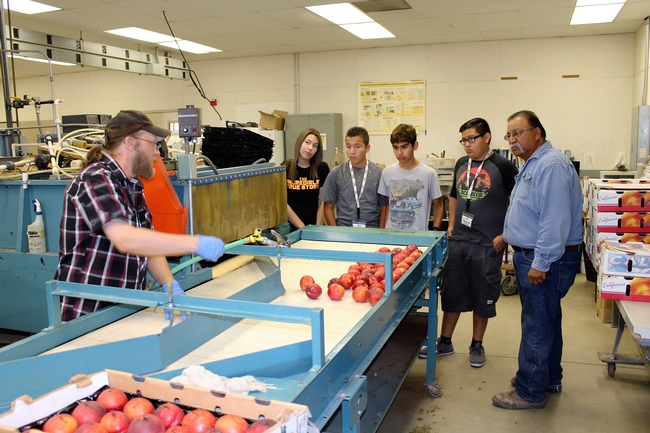
The 2016 National Farm to School Month theme is One Small Step, which highlights the easy ways anyone can get informed, get involved and take action to advance farm to school in their own communities and across the country.
Each week will have a different focus:
- Education (October 3-7)
- Healthy School Meals (October 10-14)
- Farmers & Producers (October 17-21)
- The Next Generation (October 24-28)
Join the celebrations by signing the One Small Step pledge then take your own small step to support healthy kids, thriving farms and vibrant communities this October by partnering with UC ANR.
This story en español.
UC helps Davis Farm-to-School find success for over a decade

A secret to success, says UC SAREP’s program assistant Jeri Ohmart, “is patience and persistence. Keep your eye on the prize — increasing fresh, local, seasonal products in the school meal program; and creating an environment that teaches the full cycle from garden to cafeteria to compost and back to garden.”

Ohmart, who conducts the annual evaluation says the biggest lesson learned over the last 12 years of evaluations is not how to get the freshest produce or the healthiest meal. The lessons are much more salient. “To meet the goals of the farm-to-school program requires developing solid relationships based on mutual respect and trust — with food service directors, staff, maintenance and operations, school board members, teachers, and parents. Engage the larger community in any way possible. These are the principles that have kept our program moving in positive directions despite budget setbacks and the vagaries of funding and personnel shifts.”
To learn more about Davis Farm-to-School, visit their website. Read the full Davis Farm-to-School Evaluation or the Summary and Recommendations. Learn about more of SAREP's farm-to-school work on the SAREP web site.
Farm to school programs increase children's access to fresh, seasonal produce
Farm to school programs increase children's access to fresh, seasonal produce
Eating more locally grown food could improve the health of students and the local economy

The dramatic rise of obesity and diabetes in children has prompted nutrition experts to encourage parents to offer their children a more healthful diet with more produce. Yet fewer than 10 percent of California children consume the minimum recommended daily servings of fruits and vegetables, according to a 2009 report by the Centers for Disease Control and Prevention.
"School nutrition program directors are in the driver's seat. They're already making good decisions about changing school food across their districts," said Gail Feenstra, food systems analyst for the University of California's Sustainable Agriculture Research and Education Program, who led the study. "We wanted to bring the resources of the university to bear and help them move forward."
For this three-year project, the UC researchers worked with three school districts: Oakland Unified School District, Winters Joint Unified School District (west of Sacramento) and Enterprise Elementary School District in Redding.
"The objective was to connect regional growers with school lunch programs so they could buy more fresh seasonal regional food for the school meal program," Feenstra said. "To encourage school gardening, we provided professional development for the school nutrition program directors, teachers, parents and others. We also measured kids' consumption of fresh seasonal regional food and their preferences for fresh vegetables."
The results have been positive: all three districts increased their purchases of fresh, seasonal, local produce. The definition of "local" varies depending on the location of the school district and time of year, but is generally within a 250-mile radius. Much of the success is due to the creativity of school chefs in modifying their purchasing practices and making delicious meals from the fresh produce.
Oakland Unified chef Donnie Barclift won an award from celebrity chef Rachael Ray for his recipe for pozole con pescado, a zesty tomato-based soup filled with fish and vegetables.
"I take great pride in the work we are doing to integrate into our menus, not just fresh, but fresh local seasonal produce," said Barclift. "It's also important that we are teaching kids where their food comes from and the importance of fresh produce in their daily diets. It's wonderful to get food fresh from a farm instead of a factory."
Oakland Unified School District spent $794,000 on produce the first year, of which 11 percent was local. In the final year, Oakland's total produce purchases increased to $1.36 million with 31 percent locally sourced. Winters Joint Unified School District's produce purchases leaped from $7,707 and 6.6 percent local to $43,000 and 51 percent local. Enterprise Elementary School District doubled its produce spending from $89,000 and 4.4 percent local to $177,000 and 20 percent local.

In Winters, students more than doubled their consumption of fruit and total produce. Rominger Middle School planted a new school garden that is contributing to students learning about growing their own food. WJUSD students' parents reported a significant increase in their children's consumption of kiwi fruit at home and a slight increase in overall consumption of vegetables.
Students were asked to identify, taste and rate fresh, raw produce such as asparagus, cucumber, bell pepper, cabbage and kiwi fruit. Overall, the students improved their ability to identify the selected fruit and vegetables. Students reported that they would ask a family member to purchase spinach and bell pepper and that they would eat them as a snack.
"We were excited to learn that the students exposed to this program were able to identify new types of produce and that they would ask their families to purchase these items at home. This is an important step towards increasing children's consumption of fruits and vegetables," said Sheri Zidenberg-Cherr, UC Cooperative Extension specialist in the Department of Nutrition and co-director of the Center for Nutrition in Schools at UC Davis
Each school district has reaped other benefits from the project. Oakland developed a new bid process for buying produce to specify that products had to come from local farms and was able to increase local produce purchases by 40 percent.
In Winters, parents, farmers and others formed a nonprofit farm to school organization to raise money so the school district can continue the farm to school efforts. The money will help buy fresh local produce, support school gardens and fund other related activities.
In Redding, a grower began acting as an aggregator, delivering local produce from several local farms to the school district's kitchen so the school could work with one supplier and write a single check. Enterprise Elementary School District has also added nutrition education to the professional development offered to its staff.
UC Agriculture and Natural Resources has awarded Zidenberg-Cherr's research group a grant to work on the "Shaping Healthy Choices Program" with two other school districts – Elk Grove Unified School District in Sacramento County and Sylvan Union School District in Stanislaus County. They are studying how a multi-component program that includes classroom nutrition education, family and community participation, regional produce procurement, nutrition services and school gardening can influence students' food choices, critical thinking skills and health-related outcomes. This is a highly collaborative project that relies on expertise from the Department of Nutrition, Human Ecology, Population Health and Reproduction at UC Davis, the UC Davis Agricultural Sustainability Institute, UC Davis Betty Irene Moore School of Nursing and UC Cooperative Extension in Sacramento and Stanislaus counties. The UC researchers are working with school staff and school wellness committee members to ensure the schools will be able to continue the Shaping Healthy Choices Program on their own.
Feenstra sees the key to encouraging children to eat fruits and vegetables throughout their lives as requiring more than putting the produce on their plates at school. Enticing them to try new items, getting them interested in growing food in gardens, teaching them about nutrition and involving their parents all play important roles in the learning process, she said.
"Since Cooperative Extension is a part of so many different counties, as we move forward in farm to school, I think that making sure that we involve Cooperative Extension and the nutrition education component in addition to school gardening and procurement is a really important way to think comprehensively about where we need to go next," Feenstra said.
In addition to improving children's access to fresh, seasonal produce, farm to school programs provide new markets for regional farmers.
This farm to school study was funded by a grant from the California Department of Food and Agriculture Specialty Crop Block Grant Program.
Prize-winning recipe created by Donnie Barclift, Oakland Unified School District chef

Servings: 50 one-cup servings
Raw Atlantic Pollock. As an option, you may use other types of fish such as cod or tilapia.
1. Coat baking pan with oil or melted butter.
2. Lay filets in baking pan.
3. Combine the garlic and chili powder and cumin.
4. Lightly sprinkle seasoning blend on filets and bake until done in a pre-heated 350 degree oven (about 5 to 7 minutes).
5. Once done, allow fish to sit for five minutes then cut into chunks, about 1-inch cubes.
1. Saute celery and onions in 4 TBSP olive oil until onions are translucent.
1.5 cups celery, chopped
1.5 cups onion, fresh, diced
2. Combine the sauteed onion and celery with the ingredients below in a soup pot and bring to a simmer for 20 minutes, stirring occasionally.
2 #10 can tomatoes, crushed
1 #10 can + 5 cups yellow hominy (undrained)
14 oz diced green chilis
3/4 cup chili powder
3 TBSP garlic, granulated
2 TBSP cumin
1 TBSP cayenne pepper, ground
1/2 tsp ground black pepper
3. Add kale during the last 10 minutes
4. Wash and shred the cabbage. Serve 1/8 cup on top of soup for garnish.
1.5 lb cabbage, fresh, raw, chopped
Serving the pozole:
To insure proper fish portioning, portion 1 cup of the soup into a serving bowl, then float 1 ounce of fish chunks on the soup. Serve with warm, whole-grain flat bread or another bread item that equals 1 grain bread. Half of a 6-inch whole grain flat bread is the portion. Heat in a warmer, cut into quarters before serving and serve 2 quarters of bread per bowl of pozole.
Know your farmer, know your food
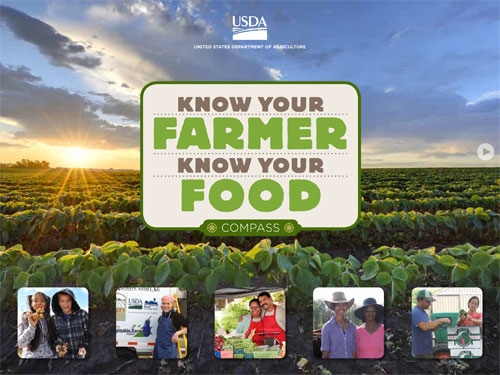
Know Your Farmer, Know Your Food is a USDA-wide effort. It is not a new department, but rather, an effort that seeks to more effectively connect existing USDA departments and work to strengthen local and regional food systems.
We know that demand for local and regional foods is strong. Per USDA statistics, the number of farmers markets has more than tripled in the past 15 years and there are now more than 7,175 around the country. The community supported agriculture (CSA) model has grown from 2 operations in 1986 to more than 4,000 today. Farm-to-school programs have experienced explosive growth, and are now found in 48 states, and total more than 2,200 (per the USDA, there were two such programs in 1996). There are “branding” efforts touting what is produced “locally” (or regionally, or statewide) in each of the 50 states.
These efforts are important: local and regional food efforts are vital to local economies, as they can often provide farmers with a higher share of the food dollar. Local jobs are supported and created in this manner, as money spent at a local business often continues to circulate within the community, creating a multiplier effect. Food dollars are good dollars.
On February 29, 2012, the USDA’s Know Your Farmer, Know Your Food initiative launched its new Know Your Farmer (KYF) Compass. The KYF Compass is a digital guide to USDA resources related to local and regional food systems. The KYF Compass organizes the USDA's work on local and regional food systems into seven thematic areas. The Compass provides tools for navigating to learn more about local and regional food systems and projects. The site enables users to secure the most up-to-date information and create interactive scenarios on a variety of topics relating to local and regional food systems, including:
- What local and regional food systems are
- Infrastructure
- Farm-to-Institution (including Farm-to-School)
- Stewardship and local food
- Local meat and poultry
- Healthy food access
- Careers in agriculture and food systems
- Case studies
- Interactive mapping tools that enable site users to locate USDA-funded local and regional food systems projects in their area (note to researchers: score!)
One of my interests is food access. The site did not fail to satisfy me in this respect. The food environment atlas tool enabled me to construct a spatial overview of the ability of specific communities to access healthy and fresh foods. In very short order, I was able to construct a rough demographic overview of how my county measured up in terms of residents’ access to grocery stores, the prevalence (and growth) of fast food restaurants, etc. This information could then be compared against other communities (or in my case, adjacent counties). This tool, along with other USDA food access tools, will prove invaluable to site users (including social science researchers). The USDA’s Economic Research Service produces some of the most cutting-edge and valuable research in this area; the site makes this information even more accessible.
The site also provides ways consumers can more directly connect with producers, a key part of building and sustaining local and regional food economies.
The Compass explicitly links food and agriculture, and shows just how interconnected the food system is with the economy, the health of communities, and the larger environment.
President Obama recently said, “Local food systems work for America: when we create opportunities for farmers and ranchers, our entire nation reaps the benefit.” The Know Your Farmer, Know Your Food initiative continues to grow, to improve and to support this vital sector of our nation’s food system.
